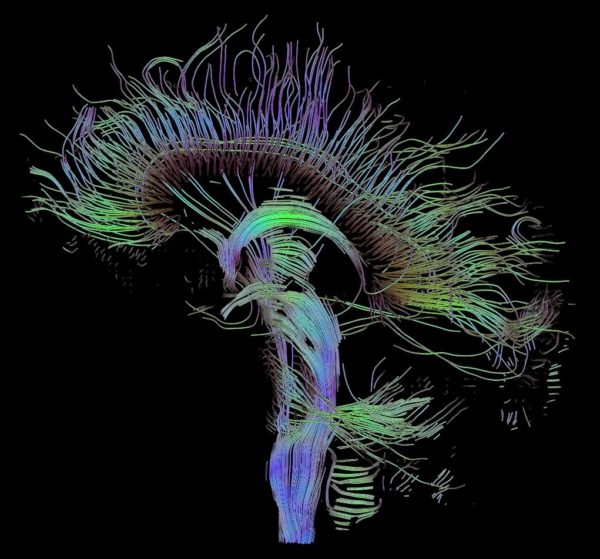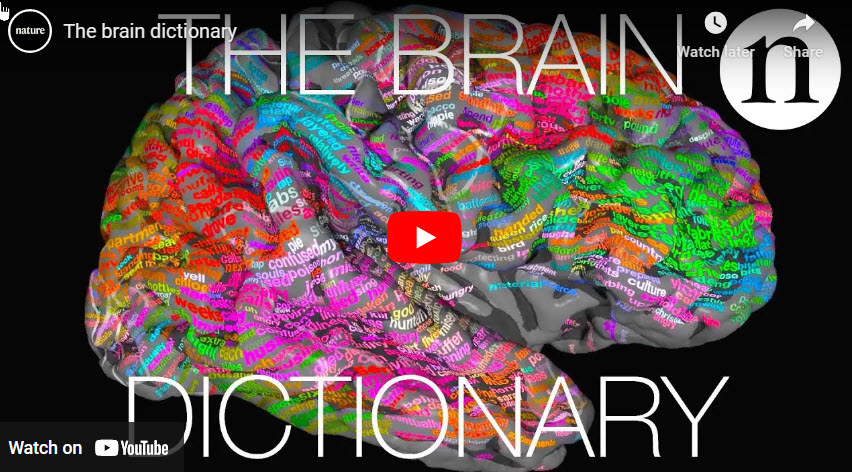Brain maps
Why create brain maps? Why map brain’s billions of neurons one at a time? April 2, 2013 President Obama announced that he was requesting 100 million dollars of the US research budget be devoted to the Brain Activity Map project. This project also goes by the name of BRAIN. That is short for Brain Research through Advancing Innovative Neurotechnologies. BRAIN is probably a better title than the original for this project – BAM.
Brain Pathways
Some work inspiring this project was break through efforts to map the white matter axon tracts in the human brain like the one pictured below.

Neuron axon tracts in human brain, courtesy of Thomas Schultz, Gordan Kindlmann and Andrew Alexander/Wikimedia Commons
The ambitious goal of BRAIN is to create a map of the brain and to understand brain circuit function. Scientists hope to complete this research over the next 20 years. When it is finished, scientists project it will be possible to record and manipulate with precision the activity of nerve circuits, nerve networks, and maybe even whole brains.
Much of the effort in this project will be devoted to building the new tools necessary to monitor neurons one-at-a-time. It is hoped that BRAIN will become a cross scientific discipline, and a collaborative effort among multinational, private, government, and industry participants.
Brain research plan
By September 2013 the U.S. National Institutes of Health (NIH) completed its first attempt at creating its plan for its role in BRAIN. Their vision is to combine nine approaches into an integrated science of cells and circuits that describe brain behavior. The nine research areas were identified as high priority in the committee’s interim report.
#1. Generate a Census of Cell Types. Characterize all of the various types of neurons present in the brain.
#2. Create Structural Maps of the Brain. Anatomic reconstruction of neural circuits at all levels.
#3. Develop New Large-Scale Network Recording Capabilities. Recording neuronal activity from complete neural networks over long periods in all areas of the brain.
#4. Develop A Suite of Tools for Circuit Manipulation. Directly activate and inhibit populations of neurons.
#5. Link Neuronal Activity to Behavior. Increase understanding of how neuronal activity underlies cognition and behavior.
#6. Integrate Theory, Modeling, Statistics, and Computation with Experimentation. New methods of data analysis and interpretation.
#7. Delineate Mechanisms Underlying Human Imaging Technologies. Develop a better understanding of cellular mechanisms underlying clinically measured brain images.
#8. Create Mechanisms to Enable Collection of Human Data. Maximize the collection of clinical imaging data for analysis of the mechanisms of brain disorders.
#9. Disseminate Knowledge and Training. Course modules for educating non-neuroscientists in computational neuroscience, statistics, imaging, electrophysiology, and optogenetics.
You may notice when reading these goals that the project was indeed focused upon neurons. There is no mention of the other 90% of the cells in the brain that modify the activity of neuronal circuitry. Many introductory – and advanced – courses in physiology and in anatomy spend little or no time teaching the nervous system. It is often the last system to be included in the teaching schedule. Now may be the time to reverse that trend and begin physiology courses by teaching the central nervous system.
Other posts on this site are designed to bring you up to date on what we already know about the human brain. My plan is help you to be ready to evaluate the meaning of data produced by the BRAIN project as it is acquired. Having the fundamental concepts of neurophysiology firmly in your mind will place you in a superior position to deal with all of anatomy and physiology.
Further reading
Birth of Neurons Continues in the Human Brain into the 5th Decade
Please put your questions in the comment box or send them to me by email at DrReece@MedicalScienceNavigator.com. I read and reply to all comments and email.
If you find this article helpful share it with your fellow students or send it to your favorite social media site by clicking on one of the buttons below.
Margaret Thompson Reece PhD, physiologist, former Senior Scientist and Laboratory Director at academic medical centers in California, New York and Massachusetts is now Manager at Reece Biomedical Consulting LLC.
She taught physiology for over 30 years to undergraduate and graduate students, at two- and four-year colleges, in the classroom and in the research laboratory. Her books “Physiology: Custom-Designed Chemistry”, “Inside the Closed World of the Brain”, and her online course “30-Day Challenge: Craft Your Plan for Learning Physiology”, and “Busy Student’s Anatomy & Physiology Study Journal” are created for those planning a career in healthcare. More about her books is available at https://www.amazon.com/author/margaretreece. You may contact Dr. Reece at DrReece@MedicalScienceNavigator.com, or on LinkedIn.
Dr. Reece offers a free 30 minute “how-to-get-started” phone conference to students struggling with human anatomy and physiology. Schedule an appointment by email at DrReece@MedicalScienceNavigator.com.


